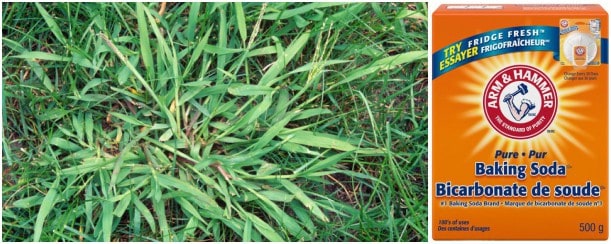A lawn that’s invaded with crabgrass and other unwanted weeds can soon be damaged if you do not take the necessary precautions to fix it. When dealing with crabgrass, you can use some chemical herbicides or natural home remedies such as baking soda.
It is hard to avoid the use of chemicals to control lawn weeds but for the most part, you can employ the use of natural home remedies such as baking soda to kill crabgrass.
How to Kill Crabgrass Using Baking Soda
When it comes to weeds, you want to have them eliminated as early as possible without affecting the grass on your lawn. That’s why you might need to apply a crabgrass preventer or pre-emergent. Here’s how to use baking soda to kill crabgrass lawn weed.
- Wet the patch of crabgrass in your lawn
- Cover the surroundings and the leaves
- Pour a fair amount of baking soda on the weed
- Uproot the dead crabgrass from the lawn. You can use a weed remover or simply a shovel.
- Reseed your lawn. Leaving the bare spots will attract new weeds. If you do not want to reseed, you can patch up the lawn by planting plugs in your lawn’s grass.

Note that this is a post-emergent natural remedy. If you are trying to prevent the weeds from germinating, use pre-emergent techniques.
Further tips to consider
These tips will come in handy when using this organic weed treatment.
- Remember to spot-treat the areas with crabgrass, otherwise, you might end up harming your lawn if you spread sodium bicarbonate all over it.
- Different lawn grasses have varying resistances. For example, Bermudagrass is fairly resistant. So, if your lawn has crabgrass weeds among Bermudagrass, you can use baking soda to kill it.
How does baking soda kill weeds?
Sodium bicarbonate works as a weed killer because of its phytotoxic properties.
Phytotoxicity is plant damage – a toxic effect – from something the plant was exposed to. Most chemical sprays that are used to control weeds in gardens, pavements, and lawns are phytotoxic.
Baking soda kills crabgrass due to its phytotoxic effect. However, it may show varying results when used on other grasses depending on the concentration and other aspects of the soil in general.
Increased salinity due to the sodium in the bicarbonate compound is highly likely to be the main weed control mechanism of this home remedy.
Note that this may come with a few side effects as well. So, let’s look at what to expect.
How Long Does It Take for Baking Soda to Kill Crabgrass?
The amount of time it takes to kill crabgrass with baking soda depends on several factors, most commonly the potency of your homemade crabgrass killer.
Killing crabgrass will be quicker if baking soda is properly absorbed by the weed. There are several tell-tale signs the baking soda is starting to work like leave turning white and wilting, which usually happens roughly within a few hours after application.
To increase absorption, sprinkle the baking soda and let it sit for a couple of hours. As time goes by, you should see discoloration of the leaves from green to yellow and brown.
When you sprinkle baking soda, it works by pulling water out of the weed’s plant tissue, killing it eventually. Herbicides contrarily work by destroying the weed’s cell membranes.
Mixing baking soda with vinegar increases its potency so you should see quicker results when killing crabgrass and certain other weeds, making it one of the best homemade crabgrass killer recipes.
Other benefits for your lawn
Kitchen baking soda has many uses. When used for lawn care, it is known to kill moss.
The sodium bicarbonate in it is also a good fungicide and will clear any fungal diseases on your grass such as mildew.
Possible side effects
Because it is a salt, baking soda can damage the grass to which it is applied. The phytotoxic property may not be selective on your lawn, meaning that you run the risk of damaging your lawn’s foliage if you apply baking it on large areas.
Resistance may depend on each grass’s resistance level. In some cases, even low concentrations can kill various plants.
According to the Michigan State University:
“Phytotoxicity is even more problematic on foliage, where even a 1 percent SBC solution can cause severe foliar damage, including interveinal chlorosis.” – Michigan State University
Precautions Before Using Baking Soda on Your Lawn
Whether you’re using baking soda sparingly or baking soda mixed with vinegar, it’s highly important to take a few precautions before use.
First, wear safety gloves and safety glasses and preferably a long-sleeved shirt during a baking soda application or when using any other natural weed killer. You should also wear safety gear when mixing and storing natural and chemical herbicides.
Adding to this, always test out a small portion when using any homemade weed killer. Keep people and pets away during application and sprinkle baking soda in calm weather to prevent it from drifting or the solution from washing away.
FAQs
How Long After the Baking Soda Application Do I Have to Wait Before Reseeding?
Don’t be in a rush to reseed your lawn after a baking soda application. Remember, it takes approximately three days for baking soda to kill crabgrass depending on the severity of the problem.
Once all the crabgrass is dead, hand-pull what’s left, clear the lawn of any debris, and then spread new grass seed.
Does Baking Soda Kill Grass?
Using baking soda to kill crabgrass is a bit risky as it contains bicarbonate – a salt that can damage the grass it comes in contact with.
Furthermore, baking soda is alkaline in nature, making it phytotoxic, and is poisonous to plants even in low concentrations.
Does Baking Soda Kill Weeds Permanently?
Baking soda does kill weeds permanently but a repeat application or two may be needed to eliminate all the weeds from your lawn for good. You can increase its potency by mixing it with other kitchen staples like lemon juice or vinegar.
Final Thoughts
Crabgrass is an invasive weed that’s tough to get rid of to say the least. Even though there are several herbicides available to kill crabgrass, baking soda is a an effective natural solution to bid adieu to crabgrass for good.
You can either sprinkle baking soda over the crabgrass or mix it with vinegar or lemon juice and spot treat the weeds without getting it on your grass and other favorable plants.
References
- Michigan State University Extension: Plant phytotoxicity in the greenhouse
- Miracle, Myth or Marketing? Baking Soda – Will Fungi Fail or Roses Rejoice
Hi, Alex Kuritz here. Growing up I remember that my family had one of the best lawns in the neighborhood. Richly green and lush. I did a lot as I grew up in terms of caring and tending for not only my family’s lawn but also my neighbors. I can say I have years of experience, and I am here to share it with you.



My lawn has crabgrass and other weeds, and it’s starting to spread since we’ve been mowing the lawn. Also, it needs reseeded. I thought about using baking soda, but I don’t want to ruin the yard, or the flowers in the beds. I need help!!!
I would give it a round of Tenacity. Check it out here https://amzn.to/2Dslnr5 Then once it dies off then put down some seed or fresh sod.
The soil in my St Augustine grass reached an average of 59 degrees over one week period. I was ready with Atrazine, which is a liquid pre emergent and applied the Atrazine. 2 days later there were light showers. How effective will this application be since it was in liquid form rather than granular form as far as soaking in the soil
It should be ok if it was only a light rain. What state are you in?
How long after the baking soda application do I have to wait before reseeding?
I’d give it a good 10 days to 2 weeks.
I had my yard landscaped 3 1/2 years ago with crushed granite. I believed that this would prevent crabgrass, that I had been battling for years, to be suppressed. Unfortunately this was not the case. The crabgrass is breaking through the plastic and CG laid down. Also, it is coming through the areas where it is near the plastic edges. I have been recently told that I cannot get rid of it, but can only maintain it. My question is how do I maintain it. I am using natural weed killer which turned it brown/yellow, but trying to remove the dead is a difficult chore. How can I maintain it before it becomes too difficult to remove?
Best is to put down a pre-emergent before it grows. Look at this page for suggestions: https://www.crabgrasslawn.com/when-to-apply-crabgrass-preventer/ Once its growing you just keep doing what you are doing and perhaps use a tool or something to help get it out of the ground. It is a pain but hey its crabgrass.